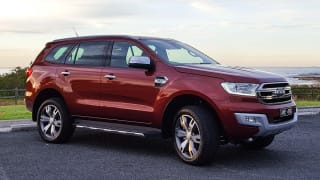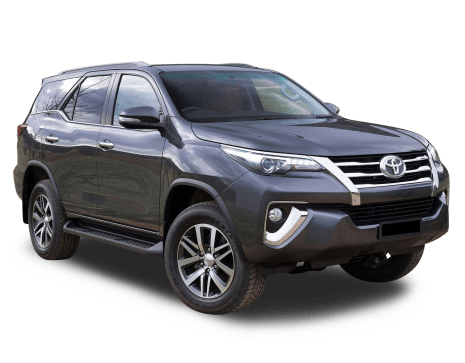
Ford Everest 2017 review
Based on the Ranger pickup truck platform, the Ford Everest launched last year to much fanfare - but is it sufficiently different to warrant its extra cost?
Browse over 9,000 car reviews

You might not realise it, but Toyota has long had a thing for 4x4-based wagons. Who remembers the 4Runner of the 1980s? It was based on Toyota’s all-conquering HiLux, but with a few key differences.
Toyota has repeated the trick with the latest generation HiLux, adding a seven-seat wagon body to the range and calling it the Fortuner.
Released in 2015, Toyota has just chopped off a sizable chunk from the recommended retail pricing as part of a 2017 refresh for the Fortuner. How does the mid-grade GXL fare in the emerging four-wheel drive (4WD) wagon space?
| Toyota Fortuner 2018: GX | |
|---|---|
| Safety rating | |
| Engine Type | 2.8L turbo |
| Fuel Type | Diesel |
| Fuel Efficiency | 8.6L/100km |
| Seating | 7 seats |
| Price from | $35,090 |
The $47,490 (before on-road costs) Fortuner GXL is the beneficiary of a recent $5500 price cut. In a highly competitive market segment, this is a big reduction from the original price. In fact, it’s now as cheap as the entry level GX used to be.
Toyota has even added extra kit… well, it’s added a new multimedia touchscreen system that incorporates satellite navigation.

Seven seats, LED tail-lights, air conditioning, cloth interior, a chilled centre console bin, the aforementioned 7.0-inch touchscreen multimedia system with sat nav and Bluetooth are standard on the 2.8-litre turbo-diesel powered GXL, which comes stock with a six-speed manual gearbox.
It also has push-button start and keyless entry, a colour TFT display for the dash, hill descent control, roof rails and fog lights over and above the spec level of the entry-level GX.
You’ll need to find $2000 more to spec it with a six-speed auto, while an all-leather interior with powered front seats is available for an additional $2500.

A half-leather wrapped steering wheel and old-fashioned rubber mats round out the spec.
The Fortuner is offered as a genuine 4x4 seven-seat wagon; hence it sits above the more car-like Kluger SUV from the same stable, but below the more luxurious - and bigger - Prado.
It goes up against rivals like the Ford Everest Trend at $58,990 (Ford will suggest its seven-seater competes against the Prado, but given its origins as a Ranger, we don’t necessarily agree), the $53,000 Mitsubishi Pajero Sport Exceed seven-seater and Isuzu’s MU-X LS-U ($50,300).

The design of the car is interesting. The front half is obviously new-gen HiLux, with its beaked nose and stylised grille, while LED tail-lights modernise the rear view, which shows a family resemblance to cars like the RAV4. Small bumps, flourishes and garnishing abounds; check out the aero bumps under the exterior mirrors, for a start.

With a tall ride height, plastic overfenders and chunky all-terrian tyres, the Fortuner certainly looks every bit an offroader in waiting. Not everyone will warm to its quirky looks, though.
Side-by-side, the 4795mm Fortuner is 10mm longer and 30mm wider than the Pajero Sport, but almost 100mm shorter and just 5mm narrower than the Everest.
It’s sold as a seven-seater, with two fold-down seats in the rear folding up and into the sides of the cargo area.
It’s not an especially practical way to carry them when stowed, though, as the folded seats cut into the rear cargo room significantly.

There’s only a flimsy hook arrangement that secures them in the locked position, and you need to fold down the inside seat rail before use.
Cargo space is affected when the third-row seats are in use, as well, with just 200 litres of usable space behind the three rows of seats. It grows to 1080 litres with the seats stowed.
Once locked in place, they can be accessed by tumbling the second-row seats forward but, given how low they’re mounted, are really only suitable for younger people.

The second row gets roof vents and a fan control, but there’s no such joy for third rowers.
Row two does get a 12-volt power socket as well as a proper 240-volt socket, while a pair of fold-up hooks in the front seat backs can handle up to four kilos of shopping bags each. Legroom is more than adequate, though the seat base is mounted quite high, which intrudes on headroom for taller passengers.
There’s a pair of ISOFIX baby seat mounts and a trio of top-tether points, as well as two cupholders in the centre armrest and bottle holders in each rear door.
A pair of manually operated seats resides up front, while an oddly half-wrapped steering wheel wasn’t a favourite with testers; the shiny veneer finish at the top of the rim was decidedly slippery if grabbed during a parking manoeuvre.

Bottles can be stashed in all doors, while a pair of cupholders grace our auto-equipped tester’s centre console. A USB and 12-volt socket are covered by rubber flaps, which along with the heavy duty rubberised floor mats are a nod to the car’s rugged aspirations.
A handful of negatives; the middle belt on the second row is mounted in the roof, and as such is a pain to access. It’s a long way up into the cabin for shorter folks, too, while the folded-up third row seats completely obscure the rear three-quarter windows when stashed.
The centre console bin, too, isn’t padded, and gets VERY annoying under your elbow after a couple of hours. We actually ended up taping a cut-up foam sleeping roll to it for our long trip.
As well, the bonnet is unfeasibly heavy – if ever there was a bonnet that needs hydraulic arms to help it, it’s this one. In fact, many people may struggle to lift it high enough to lock the support stay into place.
The Fortuner is based on the HiLux, using its ladder frame chassis, along with its front strut set-up. Instead of load-lugging leaf springs in the rear, however, the Fortuner uses coil springs and a beam axle to give it a better ride quality; it doesn’t need to carry a tonne in the rear like a HiLux.
It also uses the HiLux’s 2.8-litre turbo-diesel four-cylinder engine, and comes with either a six-speed manual or for $2000 more, a six-speed auto (as tested).
We took the GXL for a quick 1000km round trip up the north coast of NSW, and it was a comfortable and competent alternative to a more car-based SUV.
It’s a bit noisier inside thanks to its dual-purpose tyres, there’s no digital speedo (such a strange omission given the presence of a multi-function digital centre screen between the dash gauges) the steering could be more precise, and modern safety aids like adaptive cruise control and blind spot warning would have been nice to have, but we emerged after each leg in chipper condition.
The long-legged suspension is firm at low speeds, but starts to free up the faster you go, providing a more absorbent ride over square-edged bumps and rougher roads.
Steering is reasonably direct, though not especially precise, and you need a steady hand to stop it wandering off centre – a trait of most 4x4s of this size, to be fair.
The 2.8-litre engine feels strong at part-throttle, and the long travel accelerator pedal is progressive and easy to modulate.
The engine sounds and feels laboured when it’s put under load, though, and runs out of steam as it nears 3000rpm.
Outside noise is well suppressed inside the cabin, and visibility is largely okay, save for the rear three-quarter view, which is completely blocked by those (folded) third-row seats.
We didn’t get to test the GXL in the dirt, save for a drive up and down a steep, rutted, gravel-strewn fire road that would defeat a stock SUV. With a locking diff, on-demand low- and high-range 4WD and a hill-descent switch, the Fortuner was far from troubled, walking down the slope with ease and climbing up again in H4 with no drama.
Its 80-litre tank may not be large enough for more remote exploring, though.
The (1GD-FTV) turbo four-cylinder diesel from the HiLux makes 130kW at 3400rpm, and 450Nm between 1400 and 2600rpm – 30Nm more than the manual version.

Tied to a six-speed auto, it’s a relatively quiet and pleasingly smooth, tractable engine. There’s a hill-descent mode in the GXL, as well as an idle-up switch that lifts engine revs for off-road work.
The auto-equipped Fortuner can tow 2800kg, versus the manual’s 3000kg.
Against a claim of 7.8 litres per 100km on the combined fuel economy cycle, we used 66 litres of diesel to achieve a real-world figure of 8.9L/100km over 756km of testing.
Its 80-litre tank offers a theoretical range of around 1000km between fills.
Basic Warranty
3 years / 100,000 km warranty
ANCAP Safety Rating

The Fortuner does miss out on AEB, adaptive cruise control and lane departure warning, but inclusion of seven airbags, a reversing camera and sensors, as well as stability and traction control means it still scores a maximum five-star ANCAP rating. It offers trailer sway control as standard, as well.
Toyota has a fixed service program for the Fortuner that costs $240 per service for the first six services over three years or 60,000km. Service intervals of 12 months or 10,000km are suggested, and a three year/100,000km warranty is standard.
Dropping the price of the mid-spec Fortuner to the level of the previous entry-level car will improve its fortunes – but it will no doubt upset customers who bought them at full freight.
The Fortuner is a particular beast; it’s civil enough around town but its primary skill set lies in the bush or the snow.
And given the minimal additions over the base GX (essentially keyless entry, sat nav, roof rails and fog lights) we wonder if it’s five grand well spent, especially if you’re only buying it for its off-road abilities?
| Vehicle | Specs | Price* | |
|---|---|---|---|
| GX | 2.8L, Diesel, 6 SP AUTO | $35,090 – 41,800 | 2018 Toyota Fortuner 2018 GX Pricing and Specs |
| GXL | 2.8L, Diesel, 6 SP AUTO | $39,380 – 46,310 | 2018 Toyota Fortuner 2018 GXL Pricing and Specs |
| Crusade | 2.8L, Diesel, 6 SP AUTO | $45,870 – 53,350 | 2018 Toyota Fortuner 2018 Crusade Pricing and Specs |
| Price and features | 7 |
|---|---|
| Design | 7 |
| Practicality | 7 |
| Driving | 7 |
| Under the bonnet | 7 |
| Efficiency | 8 |
| Safety | 7 |
| Ownership | 8 |
$29,990
Lowest price, based on 93 car listings in the last 6 months